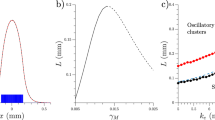Abstract
The sex pheromone system of Enterococcus faecalis is responsible for the clumping response of a plasmid carrying donor strain with a corresponding plasmid free recipient strain due to the production of sex pheromones by the recipient strain. The clumping response is mediated by a surface material (called aggregation substance) which is synthesized upon addition of sex pheromones to the cultures. Here we show that after induction a dense layer of “hairlike” structures is formed on the cell wall of the bacteria. These hairlike structures are responsible for the cell-cell contact which leads to the aggregation of cells. Formation of these structures was specific, only occurring after the addition of homologous sex pheromone.
Similar content being viewed by others
Abbreviations
- cAD1:
-
sex pheromone specific for plasmid pAD1
- cPD1:
-
sex pheromone specific for plasmid pPD1
- CW:
-
cell wall
- pAD1:
-
conjugative plasmid specifically transferred in the presence of cAD1
- pPD1:
-
conjugative plasmid specifically transferred in the presence of cPD1
- PBS:
-
10 mM Na-phosphate pH 7.5, 0.85% NaCl
References
Clewell DB, Tomich PK, Gawron-Burke MC, Franke AE, Yagi Y, An FA (1982) Mapping of Streptococcus faecalis plasmids pAD1 and pAD2 and studies relating to transposition of Tn917. J Bacteriol 152:1220–1230
Dunny GM, Brown BL, Clewell, DB (1978) Induced cell aggregation and mating in Streptococcus faecalis: Evidence for a bacterial sex pheromone. Proc Natl Acad Sci USA 75:3479–3483
Ehrenfeld EE, Clewell DB (1987) Transfer functions of the Streptococcus faecalis plasmid pAD1: Organization of plasmid DNA encoding response to sex pheromone J Bacteriol 169:3473–3481
Ehrenfeld EE, Kessler RE, Clewell DB (1986) Identification of pheromone-induced surface proteins in Streptococcus faecalis and evidence of a role for lipoteichoic acid in formation of mating aggregates. J Bacteriol 168:6–12
Handley PS, Carter PL, Fielding J (1984) Streptococcus salivarius strains carry either fibrils or fimbriae on the cell surface. J Bacteriol 157:64–72
Hennecke H, Böck A, Thomale J, Nass G (1977) Threonyl-transfer ribonucleic acid synthetase from Escherichia coli: Subunit structure and genetic analysis of the structural gene by means of a mutated enzyme and of a specialized transducing lambda bacteriophage. J Bacteriol 131:943–950
Ike Y, Clewell DB (1984) Genetic analysis of the pAD1 pheromone response in Streptrococcus faecalis, using transposon Tn917 as an insertional mutagen. J Bacteriol 158:777–783
Kessler RE, Yagi Y (1983) Identification and partial characterization of a pheromone-induced adhesive surface antigen of Streptococcus faecalis. J Bacteriol 155:714–721
Laemmli UK (1970) Cleavage of structural proteins during the assembly of the head of bacteriophage T4. Nature 227:680–685
Mori M, Tanaka H, Sakagami Y, Isogai A, Fujino M, Kitada C, White BA, An F, Clewell DB, Suzuki A (1986) Isolation and structure of the Streptococcus faecalis sex pheromone, cAM373. FEBS Lett 206:69–72
Spurr AR (1969) A low viscosity epoxy resin embedding medium for electron microscopy. J Ultrastr Res 26:31–43
Tortorello M, Adsit J, Krug D, Antczak D, Dunny G (1986) Monoclonal antibodies to cell surface antigens involved in sex pheromone induced mating in Streptococcus faecalis. J Gen Microbiol 132:857–864
Yagi Y, Kessler RE, Shaw JH, Lopatin DE, An F, Clewell DB (1983) Plasmid content of Streptococcus faecalis strain 39-5 and identification of a pheromone (cPD1)-induced surface antigen. J Gen Microbiol 129:1207–1215
Author information
Authors and Affiliations
Rights and permissions
About this article
Cite this article
Galli, D., Wirth, R. & Wanner, G. Identification of aggregation substances of Enterococcus faecalis cells after induction by sex pheromones. Arch. Microbiol. 151, 486–490 (1989). https://doi.org/10.1007/BF00454863
Received:
Accepted:
Issue Date:
DOI: https://doi.org/10.1007/BF00454863




